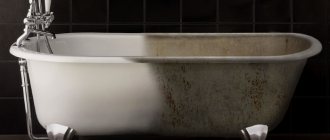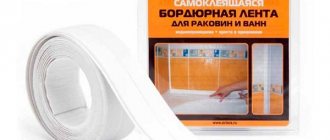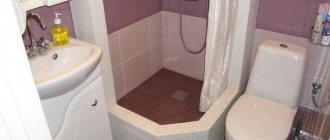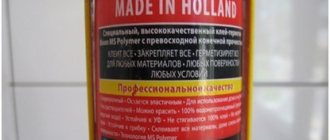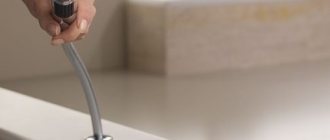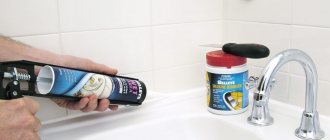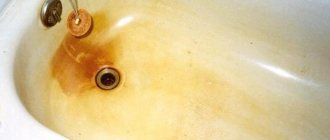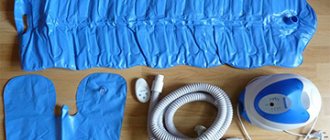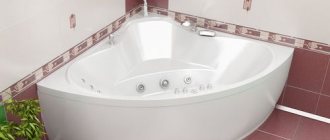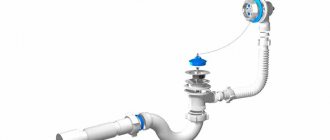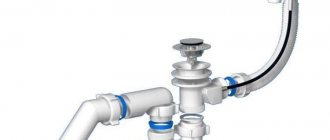Excess humidity is the main negative factor that affects the appearance and durability of finishes and plumbing fixtures in the bathroom. Despite the fact that for repairs in this room, special sustainable materials are used, developed taking into account the characteristics of its microclimate, moisture seeping into the slightest gaps leads to accelerated wear of the finish, the appearance of fungus, and an unpleasant odor.
To minimize the impact of water, completely seal the seams between the bathtub and the wall using silicone sealants, ceramic or plastic corners. A special bathtub curb tape equipped with an adhesive layer can significantly simplify the process of sealing cracks.
Why do you need a seal?
The main task of the seal is to prevent water from getting out of the shower stall, which will cause puddles on the bathroom floor and the humidity in the room will be too high.
Seals are necessary to prevent water from entering the shower stall onto the floor
It is a dense strip that is laid around the perimeter of panels and other parts of the structure to ensure tight contact between:
- swing or sliding doors;
- adjacent panels of the shower cabin;
- vertical parts of the structure and pallet;
- doors and tray;
- cabin panels and bathroom walls.
The photo shows installed seals
In order for the seal to fully perform its functions, it must meet the following criteria:
- resistance to high humidity;
- resistance to temperature changes;
- elasticity and good adhesion to the surface;
- strength and reliability.
Silicone seal
Important: despite the fact that the sealing profile may seem like an insignificant detail, it is not recommended to save on its purchase. Cheap products tend not only to wear out quickly, but also to accumulate dirt and moisture, which can lead to the appearance of fungus, mold and bacterial growth.
Device
Border tape is a special means for sealing seams, which is a long strip of polymer base, impregnated on one side with a butyl adhesive. It is sold in rolls up to 3 meters long. One package of this sealant is enough to seal the seams between the bathroom and the walls. Self-adhesive border tape has the following properties:
- Moisture resistance. The polymers from which the sealant for seams in the bathroom is made is not subject to the destructive effects of moisture. In addition, the sealing tape does not absorb water and repels it.
- Chemical resistance. The material from which the seal is made withstands the effects of aggressive household chemicals used to clean the bathtub.
- Stable adhesion. Thanks to the adhesive butyl layer and the active adhesion it has, the seal is firmly fixed on any type of finishing material.
Important! Self-adhesive tape for sealing joints between the bathtub and the wall is used only if the width of the seam does not exceed 5-6 cm. If the gap between the surfaces is larger, then it makes sense to seal it with a moisture-resistant gap or a ceramic corner.
Types of seals
There are several options for seals, which differ from each other in size and cross-section, and are also made of different materials.
Shape (type) of seal
| Type of seal | Where is it used? |
T-shaped | The fittings are installed at the bottom of the cabin door to prevent water from flowing out from under it onto the bathroom floor. |
A-shaped | Used to seal joints between two glass panels, as well as between a wall and glass. |
C-shaped | It is mounted at the bottom of the door, as well as at the junction points of the structure. |
U-shaped | A universal seal that can be used in any location. |
H-shaped | Suitable for shower cabins of non-standard shape and where the sheets do not join at right angles. |
Petal (dropper) | The fittings consist of two parts (petals): one covers the cabin threshold and seals the gap, and the second directs water splashes inside the cabin. It is especially necessary in cases where the shower drain is located directly in the floor. |
seals for shower cabins
In addition to the above types of seals, there are special profiles that are designed for installation on radius equipment. Since conventional fittings on curved glass do not hold up well, fly off from the extreme points, gather in folds and allow moisture to pass through, products with a certain bend are produced for radius cabins.
Seal for radius shower door
Plumbing sealants and special joints
The material is very common, both in installation and finishing work. With its help, organizing a simple connection between a bathtub and a wall is quite easy. However, there are some nuances here. Often, apartment owners are not satisfied with the rather modest appearance of such a solution, especially when using transparent sealant, and even complaints arise about the quality.
A significant portion of acrylic bathroom sealants, despite manufacturers' claims, are susceptible to bacterial infections. After a year or two, the joint surface turns gray or even black, spoiling the appearance of the bathtub. And this scourge can be eliminated through great efforts. Special joints are made on a mineral basis, therefore they are more practical, since the fungus interacts with them much worse.
But even when using them, the joint does not look very aesthetically pleasing. Sometimes there is quite a large gap between the wall and the bathtub. If it is at least 15 mm, the use of both types of materials is almost impossible.
Types of materials
One of the main characteristics that should be taken into account when choosing a seal is the material used to make the profile (usually rubber, silicone, PVC, thermoplastic elastomer), since each of them has its own advantages and disadvantages.
Rubber seals
Rubber compressor
Rubber shower fittings are the simplest and most inexpensive option. In terms of durability and abrasion resistance, it is inferior to modern materials, and in addition, it can accumulate dust and dirt, but it is not without some advantages. Rubber does not allow water to pass through, is resistant to humidity, most chemicals and can withstand temperature changes from -50 to +100 degrees.
Silicone fittings
Sealant (silicone) for glass in the shower cabin
Silicone products have good performance properties, including strength, resistance to high temperatures, durability and elasticity. They are resistant to mechanical damage, do not crack or cause metal corrosion, fit well to the cabin structure, ensuring its tightness, but are more expensive than rubber fittings.
Important: when choosing a silicone sealant, you should pay attention to the absence of toxic substances in the material, otherwise they will cause fumes that are harmful to health.
One of the types of silicone sealing profiles is magnetic seals. They are produced in the form of strips of a certain shape, which are equipped with magnetic elements along their entire length. These seals are installed on the cabin doors to securely lock them in the closed position. When purchasing magnetic products, you must take into account that each of them is designed for doors that close at a specific angle (90, 135 or 180 degrees). If none of the profiles fits, it is recommended to purchase fittings with a latch, the angle of which can be adjusted independently.
Magnetic seal for shower cabin
Silicone magnetic seal
It should be noted that installing a magnetic seal on the ends of the door necessarily requires the presence of hinges without fixation and a closing mechanism. If the design is equipped with hinges with a closer and a fixed “zero” position, then a so-called thrust profile can be used to protect against leaks. It serves as both a stop for swing doors and protection against splashing water.
Profile for fastening shower glass to the wall
PVC seals
PVC profiles have almost the same advantages as silicone ones. Most often they are installed on moving parts of the cabin to ensure a tight fit. Seals made of polyvinyl chloride are not subject to deformation under the influence of high temperatures, are safe for health and do not change color during operation. A wide range of PVC seals allows you to select a product of the desired width with any cross-section.
PVC seals
Thermoplastic elastomer profile
Thermoplastic elastomer is a synthetic polymer material of the latest generation. Under normal conditions, it has the characteristics of ordinary rubber, but when the temperature rises, the products soften and resemble thermoplastic. The material has a smooth surface and a uniform structure, and after deformation it regains its original appearance. Thanks to this, sealing profiles made of this polymer are durable (the average service life is 10 years), are not subject to cracking or mechanical damage, and are practical to use. The only drawback of profiles made from this material is the high cost.
Thermoplastic elastomer seals
Important: sealing profiles for shower cabins can be soft or hard, and experts recommend using products made in the form of soft tubes. They adhere much better to the joints of the structure, ensuring complete tightness.
Selection rules
In order for the seal to last a long time and guarantee maximum protection of internal structural elements from exposure to water, when purchasing you should pay attention to the following features:
- Rubber ones are not bought for dachas and houses where there is no constant air temperature. If this is a dacha where the heating is turned on only upon the arrival of the owners, then under such conditions the rubber will quickly become unusable, crack and dry out. Universal materials – silicone and thermoplastic elastomer.
- For non-standard sized booths, it is better to buy long strips, which can be cut if necessary. The fewer joints there are between the seals, the better for sealing.
- In shower stalls that have aluminum seals, it is also worth putting silicone materials inside first, since water will still flow into metal structures, and the rust accumulated on the walls will not be washed off.
- It is better to install magnetic tapes on doors that open not on a roller system, but like doors. This will help ensure ease of closure and prevent the formation of cracks and end chips of the door and wall base from glass or plastic.
- Focusing on the price of the product is also extremely important. A low price indicates the use of low-quality components in the production process.
Many buyers, when choosing seals for shower stall doors, are guided by the low cost of the product.
It seems that such a small thing cannot affect the cabin as a whole and its service life. However, it is not. If there is no seal or it wears out, water will flow onto the internal parts, which are often made of metal. Wear and rust will cause the entire cabin to need repair soon.
Seal dimensions
The thickness of the glass panels of the shower cabin can vary from 4 to 12 mm, respectively, the seals also have different thicknesses (usually 8-12 mm). Separately, it should be said about drippers, that is, seals that are installed on pallets. In this case, the height of the strip is 11-29 mm, so it should be selected depending on the design features of the plumbing.
Silicone seal for shower door. Length 183 cm
Silicone seal for shower door, length 200 cm, angle 45 degrees. Glass 6 mm
When choosing seals for shower cabins, you should make sure that there are no folds, cracks or other defects on the surface of the product, and that the profile of the fittings exactly fits the place where it will be installed.
Popular manufacturers
Design for the Siso brand
The easiest way to find fittings is from brands that are manufacturers of shower cabins. This makes it possible to quickly select the necessary fittings for a specific model of shower box.
Siso - this company is located in Denmark and produces seals in three sizes: 6, 8 and 10 mm. The 6 mm product is designed for sealing glass partitions, 8 and 10 mm seals are universal. The standard profile length is 2.2-2.5 m. The magnetic seal can be supplied with a black or white magnet.
Huppe - sanitary ware from a German manufacturer is of unsurpassed quality, including seals. They are ideal not only for Huppe shower enclosures, but also for products from other European brands. Available in sizes 5, 6, 8 mm.
Eago is a Chinese company that produces a full range of sanitary fittings and seals. The fittings are affordable and of good quality.
Pauli - the products of this brand are proof of German quality. The company produces silicone seals that have digital markings. The last 5 digits indicate the width and length of the profile in mm.
How to install the seal?
When purchasing a new shower cabin, a seal is usually included in the kit and is installed during the assembly process. It is placed in the joints between the glass and the frame, after which it is well coated with sealant.
Seals are supplied complete with the shower cabin
After assembling and installing the cabin, it is necessary to additionally seal it around the perimeter - in those places where its parts are adjacent to the walls. When performing work, it is recommended to follow the cabin manufacturer’s instructions, which indicate how and in what sequence it is necessary to assemble structural parts and install seals.
Practice using cuffs
Using cuffs, plumbing equipment (sinks, sinks, bathtubs, toilets, etc.) and household appliances (washing machines, dishwashers) are connected to the sewer network, and sewer pipes are connected. Plastic is connected to plastic using special fittings equipped with rubber sealing rings, and cast iron is connected to plastic using either adapters, couplings, or just cuffs.
To join cast iron and plastic pipes, both external and internal cuffs are used (for socketed and socketless structures). They work in stages:
- clean the connecting part of the cast iron pipe - it must be absolutely clean to ensure proper adhesion of the sealant;
- apply sealant to the cuff and insert it into the socket;
- A plastic pipe is inserted into the cuff.
If pipes have to be cut, this must be done correctly - the cut must be smooth (no nicks, even if they seem microscopic and are difficult to detect). After cutting, the part is chamfered.
In terms of the procedure for joining smooth pipes, it is not much different from socket pipes - the sealant must be applied to the collar on both sides, since the coupling is placed on top of it.
Scheme for installing a cuff on a sewer pipe (connection of smooth pipes)
Siphon connection
For this purpose, the use of a sealing collar is mandatory (there is always water in the siphon - it serves as a kind of seal). There are no difficulties in connecting the siphon - you can easily do it yourself without any special knowledge. First, the siphon itself is assembled according to the instructions (the accompanying documentation must be available, otherwise you should not buy the equipment: the configuration is different, and the assembly instructions vary accordingly). Then connect the pipe:
- to the siphon;
- to the sewer (simply inserted into the fitting hole intended for this purpose).
If the fitting on the riser is equipped with an O-ring, the collar is used only to connect the pipe to the siphon.
In what cases is it necessary to replace the seal?
Over time, even the highest quality and most reliable fittings become unusable and cease to fully perform their functions. If condensation begins to settle on the walls of the bathroom, and water flows out of the cabin, do not hesitate to replace the seal. Insufficient sealing of the cabin will lead to high humidity in the room all the time, and fungus and mold will appear (there is no point in fighting them, since they will appear again anyway). In order to replace fittings in a shower stall, it is not necessary to contact a specialist - you can do all the work yourself.
You can replace the seals in the shower stall yourself
Care instructions
To extend the service life of the fittings, adhere to the following rules:
- regularly treat seals with non-aggressive detergents to remove dirt and soap deposits;
- do not use aggressive detergents to clean rubber profiles, because this causes them to lose their elasticity and crack;
- the bathroom is periodically ventilated so that moisture does not stagnate in the room, creating conditions for the growth of fungus and mold;
- When taking a shower, you should not direct water onto the fittings - the less water that gets on it, the longer it will last.
Despite compliance with the care requirements, over time the seals will still fail.
Instructions for replacing the seal
To replace the shower cabin seal, you will need the appropriate fittings, a simple set of household chemicals (degreasers, solvent), as well as a special sealant, the choice of which should also be given special attention.
How to choose a sealant for a shower stall?
Sealant for shower cabin
In order for the seal to fit as tightly as possible to the structural parts, it is imperative to use a sealant during installation. There are several options for sealants that are used to treat shower enclosures. Polyurethane-based compositions are very popular today, but it is important to remember that some components can hopelessly damage an acrylic or plastic surface.
Helpful Hint: You can do a simple test before using the sealant. Apply a small amount of the composition to a regular plastic bag, then wait until it hardens. If the package becomes blistered or wrinkled, the material is not recommended for use on plexiglass or acrylic structures.
Another option is acrylic sealant, but it is not recommended to use it in wet areas. The optimal solution for shower stalls is silicone plumbing sealant. It not only seals all cracks and joints well, but also prevents the development of fungus and mold. The best composition for sealing a shower stall should contain at least 45% silicone rubber, the same amount of hydrophobic filler, a plasticizer, as well as special additives (fungicides, etc.).
Silicone Plumbing Sealant
Replacing the shower seal
In order for the seal to fully perform its functions and last as long as possible, it is necessary to correctly perform the work of replacing old or worn-out fittings.
Seal that needs replacing
Step 1. Remove the old seal. Usually this can be done by hand, but sometimes you have to use a knife (in this case the work must be done carefully so as not to scratch the cab panels).
The seal on the door glass is very easy to remove.
Step 2. The sealant on which the old seal was glued must be removed. The most effective and safe way is to use alcohol or alcohol-based solvents. The entire area to which the material is applied should be blotted with a cloth soaked in alcohol, after which it will become jelly-like and can be easily cleaned from the surface. If after this procedure yellow spots remain on the panels, they can also be easily removed with alcohol.
How to remove the seal at the junction with the walls
You can wipe the joint with the wall using an old toothbrush
Step 3. Rinse the treated surfaces well, treat with a degreaser and dry. In this case, it is unacceptable to use soap solutions, as they impair the adhesion of the fittings to the structural parts.
Wait until all surfaces are dry or dry them with a hairdryer
Step 4. First, the seal is mounted on the inside of the cabin. To avoid damaging the panels, their edges must be covered with masking tape or film.
On the left is a dismantled seal, on the right is a new one
Step 5. The places where the seal will be laid should be lubricated with a thin layer of sealant. Remove excess material immediately with a rag, otherwise it will be almost impossible to get rid of stains later.
Squeeze out the sealant, guiding it along the seam
Distribute the sealant along the seams
Step 6. Place the fittings tightly in the prepared areas and press them well to the surfaces.
The seal is placed with a drip towards the cabin so that drops of water flow into the pan
Move the seal until it takes the desired position on the glass
Step 7 . After laying the seal inside the cabin, you need to seal it outside in the same way.
Step 8. After installing the fittings along the entire perimeter of the cabin, the connections between the panels, tray, floor and bathroom walls need to be sealed again with sealant.
After the sealant has dried (the time is indicated in the instructions for the material), you need to check the tightness of the seals to the cabin parts. To do this, direct a stream of water to the joints - if it does not seep through the circuit, it means the installation was done correctly. If leaks are detected, problem areas should be cleaned again and treated with sealant.
Seal on glass door
Installation steps
Installing a sealing line in a shower stall or on a door does not require professional skills - you can do it yourself in 5 minutes.
On the panel
You can install the seal yourself using silicone or acrylic liquid sealant. To replace the old sealing tape, carry out the following steps sequentially and step by step:
- Remove old residues of sealant and sealant without using a knife. If the previous sealant fits tightly to the wall or glass, and it is difficult to tear it off, then you can initially warm it up with a hair dryer, and then remove it with something hard, but not sharp.
- Carry out a clean cleaning of the area intended for the seal.
- Treat the surface with a degreaser or, if available, with simple acetone for nail polish remover.
- Wait until the base dries.
- Apply a small bead of liquid silicone or acrylic sealant to the inside of the seal. You can apply it directly to the base of the wall, but in this case you need to make sure that the sealant does not slip along with the sealant that is placed on top, or smear.
The seal (except rubber) can be preheated with a hairdryer so that it is warm and bends well.
- Place the tape on the base or door, hold for 5-10 seconds and release.
- Check for leaks and repair if necessary.
At this point, all work on replacing the sealed base or tape is completed. After application, you should wait for the adhesive mixture to dry completely, the timing of which can be read in the instructions. As a rule, the time until complete drying is no more than 24 hours.
On the door
Fastening and mounting the seal on the door is carried out similarly to the above method. The main thing is to ensure dryness during the fastening process and to degrease and dehydrate the surface to be treated.
Properties of sealing elements and materials of manufacture
For sealing to be effective, cuffs must have the following properties:
- elasticity;
- elasticity;
- ability to withstand temperature changes within certain limits;
- strength and long service life.
Rubber products fully possess these properties, therefore sealing couplings and cuffs for sewage pipes and transitional shaped elements are made of varieties of this material, such as:
- the actual rubber;
- paronitis;
- rubber;
- silicone
Sometimes manufacturers add polymer substances to the rubber composition, which makes rubber seals for sewer pipes more rigid, less convenient during installation work, but at the same time wear-resistant and durable.
Some types of cuffs, for example those that are equipped with adapter couplings for connecting the toilet flush to the sewer pipe, are made of polyethylene. In conditions of large diameter connecting holes (at least 110 mm) often of irregular geometry, this material demonstrates better tightness and wear resistance (rubber cuffs after dismantling have to be replaced with similar ones).
About bellows connections for mixers
Flexible connections to faucets have different options. One of the most popular is bellows-type eyeliner. It has a number of advantages in comparison with other similar devices.
4.1. Advantages
Among the many positive characteristics, the following can be highlighted:
- made from high quality stainless steel;
- reliably protected from water hammer;
- high-quality operation is possible for a long time;
- resistant to possible sudden temperature fluctuations, can fully function at temperatures up to 230-250⁰C;
- hygienically clean, safe for health, device;
- does not burn.
4.2. Flaws
There are several negative aspects associated with the use of bellows liner:
- the appearance of hum, noise, vibration processes of corrugated tubes;
- When several consumers are connected simultaneously, increased vibration is observed.
Interestingly, the larger the diameter of the liner, the less the hum becomes. Excess noise disappears with plastic sleeves.
The option of eyeliner with non-toxic rubber braid is also quite popular.
If the sewer line becomes clogged, residents of the lower floors will suffer from contaminated water that pours out through the toilet or bathtub. This problem can be solved quite simply: install a check valve. This device can only pass wastewater in one direction and eliminates the possibility of the medium moving in the opposite direction. The principle of its operation is the same as a similar brass device that is used in drinking water lines.
Pros and cons of cuffs
The sealing rubber cuff for sewerage 100 has a number of advantages.
It is characterized by:
- reliability, which eliminates the possibility of water flowing out of the sewer line, since the plastic can be perfectly fixed in a cast iron pipe;
- ability to withstand sudden pressure changes ranging from 50 to 150 kPa;
- breadth of the model range. Since hydraulic seals come in different diameters, they can also be used to connect risers of different diameters;
- budget. The price of the seals is so low that it is completely affordable for the average citizen.
The negative aspects include the fact that in order to mount the cuff in the right place it is necessary:
- the presence of sockets at the ends of cast iron pipes;
- bring the inner surface to almost perfectly flat and smooth.
A sealing collar is necessary when connecting the siphon to the sewer system. You need to remember that you should first start assembling the siphon itself, and only after that – connecting the device to the main line.
Elements of external sewerage
In addition to the pipes themselves, revisions and bends, the outer section of the drainage system also includes several specific elements. In the case of an autonomous sewer system, wastewater needs to be stored somewhere while it is being cleaned, so you will need to build a septic tank, or better yet, a septic tank.
Construction of a settling tank
Sewage settling tanks are a regular pit in which wastewater settles, large particles settle to the bottom, after which the clarified wastewater moves to the next stage of treatment. Externally, the sump looks like a pit with reinforced walls and bottom (or a special container).
If the sump is built independently, then the instructions look like this:
- a hole is dug in the ground (depth approximately 2.5 m, cross-section at least 2.0x2.0);
- a cushion of a layer of gravel is poured onto the bottom of the pit, on top of which a sand layer is placed;
- after this you need to seal the bottom and walls of the pit. You can build formwork, place a reinforcement frame in the pit and fill the walls and bottom of the pit with concrete mixture; you can reinforce the walls with brickwork;
when the concrete hardens, all that remains is to concrete the ceiling and arrange ventilation for the sump.
You can go the other way; instead of labor-intensive concreting, many use large-volume plastic containers for sedimentation tanks. These can be Eurocubes, plastic barrels, metal barrels in which paint and varnish materials were previously stored. The price of installing a sump in this case is low, but tightness is ensured.
There are also budget options for settling tanks. From ordinary truck tires, you can build a septic tank suitable for irregularly used sewage systems.
Septic tanks stand apart. Externally, such a container looks like a large barrel with ventilation pipes, and the internal space is divided into separate zones: first, the wastewater settles, then through the overflow system the liquid enters the second section, where final cleaning occurs.
Fluoroplastic pipes and barrels for sewerage
Separately, it is worth mentioning fluoroplastic barrels for sewerage. PTFE itself is an interesting material. Pipes and barrels made from it can be used in the temperature range from -100ᵒС to +250ᵒС. In addition, fluoroplastic is strong and durable.
Note! Fluoroplastic is an inert material; it does not react even with very aggressive substances; in this indicator it even surpasses platinum and gold. Therefore, using it in ordinary sewerage is not entirely justified.
Most often, fluoroplastic pipes and barrels are used in the chemical industry.
